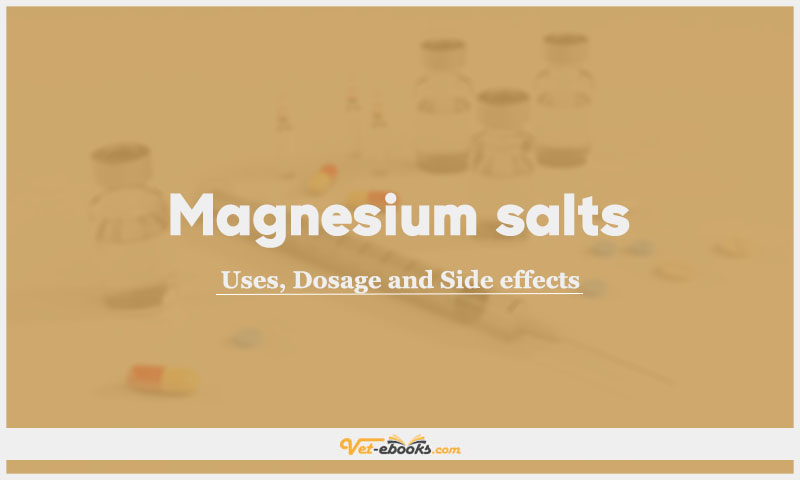Magnesium salts In Dogs & Cats: Uses, Dosage and Side Effects

Overview
- Muscular excitation and neural transmission play a crucial role in physiological processes.
- The cofactor plays a crucial role in multiple enzyme systems and the regulation of ionic gradients.
Uses of Magnesium salts
- The management of unresponsive ventricular arrhythmias, particularly in cases when hypokalemia is present and there is a possibility of concomitant hypomagnesemia.
- Infusions and oral administration are employed for the treatment of hypomagnesaemia.
Dose of Magnesium salts in Dogs and Cats
Dogs, Cats:
- Life-threatening ventricular arrhythmia: 0.15–0.3 mEq/kg i.v. administered over 5–15 min.
- Magnesium replacement: 0.75–1.0 mEq/kg/day by continuous rate infusion in 5% dextrose has been advocated for the first 24–48 hours, followed by a lower dose of 0.3–0.5 mEq/kg/day for 3–5 days to allow complete repletion of magnesium stores.
Drug Dosage Calculator
You Should Give:
Side Effects of Magnesium salts in Dogs and Cats
- The occurrence of somnolence, central nervous system depression, and even coma, as well as muscle weakness, bradycardia, hypotension, respiratory depression, and prolonged Q-T intervals, has been observed, often as a result of excessive dosing.
- Elevated concentrations can lead to neuromuscular paralysis and cardiac cessation.
Contraindications of Magnesium salts in Dogs and Cats
- It is contraindicated to administer this medication to individuals with heart block or myocardial injury.
- The use of magnesium should be avoided in individuals with renal impairment or failure, as the kidneys play a crucial role in excreting magnesium from the body in proportion to its serum levels.
Some Notes:
- To prevent the occurrence of hyperkalemia, it is recommended to decrease the administration of intravenous potassium supplementation.
- It is crucial to regularly monitor the levels of serum magnesium, as approximately 30-35% of it is bound to protein while the remaining portion exists in its ionised form.
- Magnesium can be safely combined with 5% dextrose and calcium gluconate in solution.
- In the event of a potential overdose or complications, it is advisable to be prepared for appropriate treatment, which may involve the use of ventilatory support and intravenous calcium gluconate.
- It is important to consult the relevant product information on a case-by-case basis.
- The occurrence of additive effects can be observed when other central nervous system depressants, such as barbiturates and general anaesthetics, are concurrently administered.
- It is not recommended to utilise non-depolarizing neuromuscular blocking medications due to the potential for significant neuromuscular blockade.
- Extreme caution should be exercised when using digitalis glycosides due to the potential occurrence of significant conduction abnormalities.
Tip
Do You Want To Increase Your Veterinary Knowledge and Practical Skills?
You Can Now Browse and Download +3000 Books For Veterinary Professionals & Students Online.
Download Veterinary Books




















